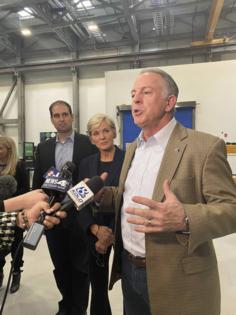Tesla co-founder JB Straubel has built an EV battery colossus
Published in Business News
In the scrublands of western Nevada, Tesla co-founder JB Straubel stood on a bluff overlooking several acres of neatly stacked packs of used-up lithium-ion batteries, out of place against the puffs of sagebrush dotting the undulating hills. As if on cue, a giant tumbleweed rolled by. It was the last Friday of March, and Straubel had just struck black gold.
Earlier that day, his battery-recycling company, Redwood Materials, flipped the switch on its first commercial-scale line producing a fine black powder essential to electric vehicle batteries. Known as cathode active material, it’s responsible for a third of the cost of a battery. Redwood plans to manufacture enough of the stuff to build more than 1.3 million EVs a year by 2028, in addition to other battery components that have never been made in the U.S. before.
It’s a turning point for a U.S. battery supply chain that’s currently beholden to China. The world’s second-biggest economy controls 70% of the planet’s lithium refining capacity and as much as 95% of production for other crucial materials needed to make EVs, according to BloombergNEF. Redwood is attempting to break that stranglehold by creating a domestic loop using recycled critical metals.
“The responsibility weighs on me,” Straubel said. “I remember feeling it in the early days at Tesla, when the other manufacturers hadn’t done crap yet, and we had a very palpable sense of holding the flag and running out into the field and saying ‘EVs are the future!’ We felt that if we failed, well, nobody’s going to follow. This is a little déjà vu.”
Redwood’s engineering hub sits atop a 300-acre slope of buildings in various states of completion. The vibe is closer to a military command outpost than an industrial processing plant. Operations are set up in a giant windowless tent, recalling the structures Elon Musk deployed for building Model 3 electric vehicles and Starship rockets. Long clusters of computer desks sit out in the open with a few small cubicles erected haphazardly in the middle of the hangar-like space for semi-private meetings.
The tent operations were about to relocate to a massive new office complex that’s just been completed further down the hill. The locational hop-scotch is typical of the constant state of flux at Redwood, where an executive team plucked from Austin-based Tesla Inc.’s top engineering ranks has been reinventing the battery-recycling process for speed and environmental efficiency — even as it expands at industrial scale.
The company’s rapid progress flummoxed a group of independent Stanford researchers who were given access to Redwood’s data over the last two years to conduct an environmental assessment of its battery recycling. By the time the researchers would finish analyzing part of Redwood’s process, they’d discover that process had changed, said Will Tarpeh, an assistant professor of chemical engineering and one of the paper’s senior authors.
“Month to month, they were always tweaking,” Tarpeh said. “That made it challenging but was fantastic to see. They are navigating very well through a world where everything is shifting very quickly.”
The Stanford report, which was still under peer review, found that Redwood’s recycling and refining operations cut carbon dioxide emissions by 70% compared with traditional recycling methods and 40% compared with other recycling processes. The savings were even greater when Redwood was dealing with manufacturing scrap, which currently makes up roughly half of the materials available for recycling.
EVs already have a much smaller environmental footprint than internal combustion cars, even in countries that still get most of their electricity from coal. While the toll of mining the raw materials for batteries is considerable, more than 95% of the key minerals can be profitably recycled.
...continued
©2024 Bloomberg L.P. Visit bloomberg.com. Distributed by Tribune Content Agency, LLC.







Comments